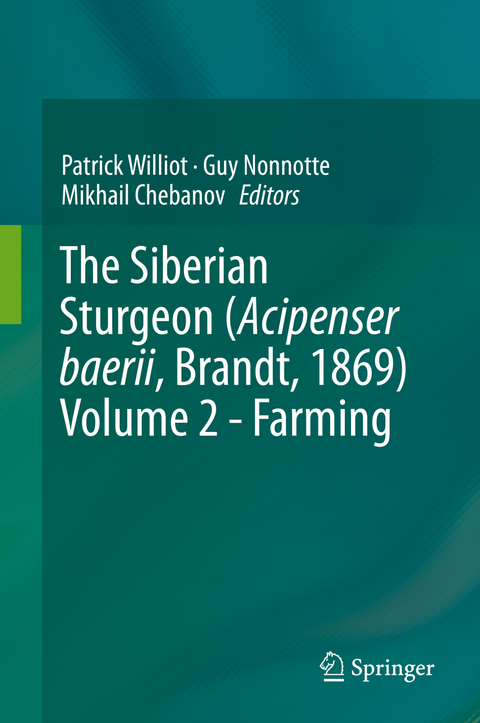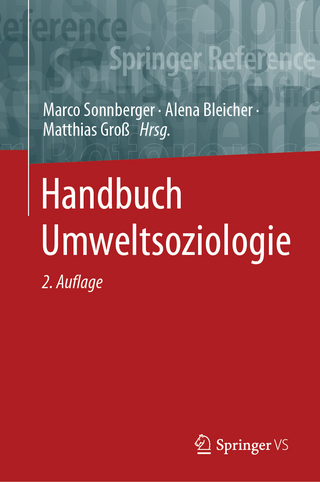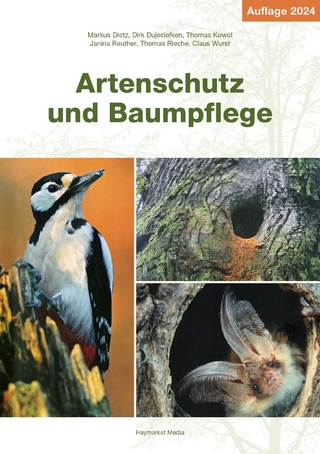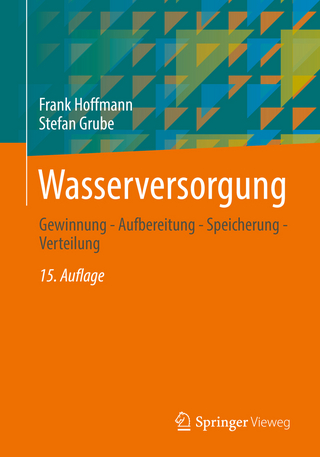
The Siberian Sturgeon (Acipenser baerii, Brandt, 1869) Volume 2 - Farming
Springer International Publishing (Verlag)
978-3-319-61674-2 (ISBN)
The Siberian sturgeon, Acipenser baerii Brandt 1869 is the most widely farmed sturgeon species. Continuing from Volume 1, which focuses on the biology of the species, the present Volume 2 in turn examines farming aspects. It is divided into six parts, the first of which deals with reproduction and early ontogenesis, i.e. reproductive cycles, controlled reproduction, sperm cryoconservation, and weaning of larvae. The second covers the growing phase with a focus on food and feeding (management, fish meal replacement, potential endocrine disruptions, usefulness of prebiotics and immunostimulants, and nitrogen excretion). Production-related data are the focus of the third part and include: characteristics (countries, structures of production, evolution in production, economic features) of the gross production of the species (meat and caviar) worldwide, a method for assessing the quality of caviars, off-flavors management, and an example of production of fingerlings for restocking. Part four addresses selected long-term management issues: genetic variability of brood stocks, genome manipulation and sex control, and the advantages of hybrids. The next three chapters constitute the fifth part, which is devoted to health status (immunology and welfare). In closing, the absence of ecological risks of introducing the species in non-native waters is shown using two long-term documented examples (Russia and France). Three methodological chapters round out the volume, covering: in vitro incubation of ovarian follicles, a richly illustrated library of echographies and photos, and a detailed presentation of oxygen demand studies.
Patrick WilliotPatrick spent the three quarters of its professional career primarily to take the challenge of the disappearing of the European sturgeon, Acipenser sturio. To achieve this task, he mobilized all the means of research (both applied and fundamental lines, biological model, national and international cooperation’s), and management (private-public partnership, transfer of know-how, installation of a new experimental facility, search for regular financial support). Patrick has developed his activity around the couple [aquaculture-conservation biology]. Patrick stimulated the development of sturgeon farming primarily in France based on the biological model, the Siberian sturgeon, Acipenser baerii. He has been the kingpin of the First International Symposium on sturgeon held in Bordeaux in 1989 where he launched the concept of the international association for the conservation of sturgeons which was installed (the WSCS; wscs.info) some year later. Later on, he edited the peer-reviewed proceedings (Acipenser), served as scientific committee member of further International symposia on sturgeons as well as the sturgeon specialist group of the IUCN, and organized other symposia and workshops. He succeeded in obtaining for the first time the controlled reproduction of farmed European sturgeon in 2007 which avoided the species from a complete disappearing and opened the door for a restoration. Patrick initiated and carried out the edition of a book on Biology and Conservation of the European sturgeon (2011) and on the biology and farming of the Siberian sturgeon which is in process. Patrick published about 90 papers in peer-reviewed journals or books. Professor Guy NonotteDoctor of the University of Strasbourg, Guy NONNOTTE was appointed research officer at the CNRS in the Laboratory of Comparative Physiology of the Regulations at F-Strasbourg in 1974. He conducted original research especially on cutaneous respiration and skin ionic exchanges on many models of freshwater and sea-water fish. In 1986, he joined the Laboratory of Neurobiology and Compared Physiolgy, (CNRS and University of Bordeaux I, F-Arcachon) and pursued research on extracellular acid-base balance and cell volume regulation in fish exposed to environmental changes and pollutants with a specific interest for the model « Siberian sturgeon ». He supervised a thesis on the toxicity of ammonia for the Siberian sturgeon in collaboration with Dr. Patrick Williot. He took also the opportunity to initiate an important collaboration concerning the respiration, the acid-base balance and the physiological effects of environmental stress for the Siberian sturgeon with the Laboratory of Animal Physiology, F-Brest. In 1994, he was appointed Professor of Animal Physiology (fish physiology) at the University of Brest (France) and managed the Laboratory of Cellular Biology and Physiology. He wrote numerous publications in international reviews and managed several thesis on fish physiology. He was also appointed for numerous evaluations and jury of thesis by INRA, IFREMER, INSERM and CNRS. In 2002, he was designed Vice-President of the University of Brest, responsible of the research and in 2007, Emeritus-Professor of the Brest University. Mikhail S. Chebanov, Prof.,Dr.Sc. is Professor of Department of Aquatic Bioresources and Aquaculture of Kuban State University and Director of State Regional Centre for Sturgeon Gene Pool Conservation “Kubanbioresursi”, Ministry of Natural Resources (Krasnodar , Russia). He has developed technology of the all-year-round reproduction of the different sturgeon species as well as the selection and breeding program and the formation of largest sturgeon living gene bank. He was developed and widely implemented the method of ultrasonic diagnostics of sturgeon for optimization of broodstock management. In 2004 he was awarded by Prize of Government of Russia in the field of Science and Technology for “Development and Implementation of technology of control reproduction and commercial rearing of sturgeon “Many years Chebanov serve as director of South Branch Federal Center of Genetics and Selection for Aquaculture, consultant FAO and convener – ad hoc Working Party on Management of Sturgeons European Inland Fisheries Advisory Commission (EIFAC FAO), deputy chair and member – Sturgeon Specialists Group of the World Conservation Union (IUCN). Prof. Chebanov is co-founder and member of Board of Directors – World Sturgeon Conservation Society (www.wscs.info ) and has chaired numerous workshops and conference sessions, including several International Symposia on Sturgeon (1993-2017). He is the author of more than 170 scientific papers, including 12 books.
Part I: Reproduction and Early Ontogenesis.- Reproductive Cycles in Sturgeons with a Special Focus on the Farmed Siberian Sturgeon.- Controlled Reproduction of Farmed Siberian Sturgeon Acipenser Baerii Brandt.- Siberian Sturgeon Sperm Cryoconservation.- Weaning in Siberian Sturgeon Larvae.- Part II: Ongrowing.- Food and Feeding: Food Characteristics and Feeding Management on Sturgeon with a Special Focus on the Siberian Sturgeon.- Reasons and Possibilities of Fish Meal Replacement in the Siberian Sturgeon.- Endocrine Disruption in the Siberian Sturgeon Acipenser Baerii Fed a Soy Containing Diet.- Pre-Probiotics and Immunostimulants in the Siberian Sturgeon: Gut Microbiota and Immunomodulation.- Excretion: Nitrogen Excretion in Sturgeons with Special Emphasis on the Siberian Sturgeon: Methods, Effects of Food, Feeding and Size.- Part III. Production: Caviars: How To Describe And Compare Their Qualities?.- The Sensorial Approach: The Off Flavors Management in the Production of Farmed Sturgeon.- Fingerlings for Restocking: Artificial Reproduction of Siberian Sturgeon Fingerlings for Restocking the Siberian Rivers of the Ob-Irtysh Basin: A Synthesis.- Production: An Assessment of the Characteristics of World Production of Siberian Sturgeon Destined to Human Consumption.- Part IV: Long-Term Management of Brood Stock.- Hybrids with the Siberian Sturgeon.- Sex Control: Genome Manipulation and Sex Control in the Siberian Sturgeon: An Updated Synthesis with Regard to Objectives, Constraints and Findings.- Genetics: Genetic Variability in Farmed Brood Stocks of the Siberian in Poland.- Genetic Variability in Farmed Brood Stocks of the Siberian Sturgeon in Russia.- Part IV: State of Health.- Immunology: Immunology In Sturgeons with a Focus on the Siberian Sturgeon Mechanisms, Responses to Stress and Stimulation.- Welfare: Welfare in the Cultured Siberian Sturgeon, Acipenser Baerii Brandt: State of the Art.- The Plasmatic Indicators of the Welfare of Juveniles Siberian Sturgeon.- Part V: Ecological Risks.- Synthesis of Introduction Trials of Siberian Sturgeon in North European Part of Russia.- Synthesis of Escapements of Farmed Siberian Sturgeon in French Catchments: Some Extreme Events and a Lot Punctual Accidents.- Part VI: Specific Methods.- In Vitro Incubation of Ovarian Follicles of Cultured Siberian Sturgeon, Acipenser Baerii Brandt: A Short Practical Implementation and Its Fundamentals.- Echography for Siberian Sturgeon Brood Stock Management.- Oxygen Demand in Sturgeon Farming.- General Conclusions on Volume 2: Which Future for the Siberian Sturgeon Farming?
| Erscheinungsdatum | 16.03.2018 |
|---|---|
| Zusatzinfo | XVIII, 590 p. 231 illus., 164 illus. in color. |
| Verlagsort | Cham |
| Sprache | englisch |
| Maße | 155 x 235 mm |
| Gewicht | 966 g |
| Themenwelt | Naturwissenschaften ► Biologie ► Ökologie / Naturschutz |
| Naturwissenschaften ► Biologie ► Zoologie | |
| Weitere Fachgebiete ► Land- / Forstwirtschaft / Fischerei | |
| Schlagworte | Acipenser baerii • agricultural science • Agriculture • Animal physiology • Biomedical and Life Sciences • Caviar • conservation • Conservation of wildlife & habitats • Conservation of wildlife & habitats • Ecological science, the Biosphere • farming • Fish & Wildlife Biology & Management • Fish and Wildlife Biology • Fish & Wildlife Biology & Management • Food & beverage technology • Food & beverage technology • food science • Freshwater & Marine Ecology • Freshwater & Marine Ecology • hydrobiology • Life sciences: general issues • Limnology (inland waters) • Marine & Freshwater Sciences • marine and freshwater sciences • Marine & Freshwater Sciences • Restocking • Siberian Sturgeon • Zoology & animal sciences • Zoology & animal sciences |
| ISBN-10 | 3-319-61674-9 / 3319616749 |
| ISBN-13 | 978-3-319-61674-2 / 9783319616742 |
| Zustand | Neuware |
| Haben Sie eine Frage zum Produkt? |
aus dem Bereich


